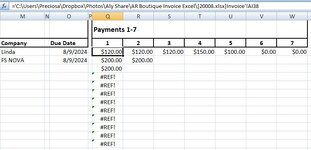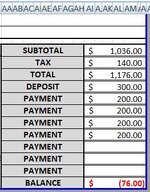Code Ghost
New Member
- Joined
- Apr 9, 2024
- Messages
- 16
- Office Version
- 2007
- Platform
- Windows
Good morning,
I'll try to be concise.
I am retrieving a value in currency from a saved Invoice to a Record of Invoices Workbook (Two pictures are inserted for reference.)
I am actually retrieving seven different payments from a column in the saved Invoice to a row in the Record to calculate pending balances.
The row in the Invoice with the balances contains merged cells (I am not sure this is of consequence).
I have manually copied the path from an invoice saved as 20008 (no reason for this) to the next cell in the row below. I, then, modified the path to reflect the next Invoice. Instead of copying a payment from invoice 20008, now it will copy a payment from invoice 20009.
Thank God, as I saved the new invoice 20009, the first two payments were copied to the record giving me a new balance (I did not yet copy down the other columns for the rest of the payments).
Now I need to modify the path for the next payments in columns R to W (The payments are recorded in rows Q to W).
For each column, I need, in addition to changing the invoice number, to change the row that reflects the payment in the invoice:
Column Q reflects payment in row 38.
Column R reflects payment in row 39.
And so on.
If I had to modify the path to 100 rows I would do it manually, but I need to do this for at least 10,000 rows accounting for a year in sales.
I think VBA would help, but it's just beyond me at the moment.
I beg of you, o, wise ones! (I just read that in an Avengers comic)
I appreciate in anticipation all the help and advice given.
I'll try to be concise.
I am retrieving a value in currency from a saved Invoice to a Record of Invoices Workbook (Two pictures are inserted for reference.)
I am actually retrieving seven different payments from a column in the saved Invoice to a row in the Record to calculate pending balances.
The row in the Invoice with the balances contains merged cells (I am not sure this is of consequence).
I have manually copied the path from an invoice saved as 20008 (no reason for this) to the next cell in the row below. I, then, modified the path to reflect the next Invoice. Instead of copying a payment from invoice 20008, now it will copy a payment from invoice 20009.
Thank God, as I saved the new invoice 20009, the first two payments were copied to the record giving me a new balance (I did not yet copy down the other columns for the rest of the payments).
Now I need to modify the path for the next payments in columns R to W (The payments are recorded in rows Q to W).
For each column, I need, in addition to changing the invoice number, to change the row that reflects the payment in the invoice:
Column Q reflects payment in row 38.
Column R reflects payment in row 39.
And so on.
If I had to modify the path to 100 rows I would do it manually, but I need to do this for at least 10,000 rows accounting for a year in sales.
I think VBA would help, but it's just beyond me at the moment.
I beg of you, o, wise ones! (I just read that in an Avengers comic)
I appreciate in anticipation all the help and advice given.








